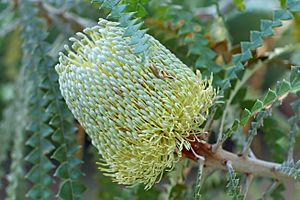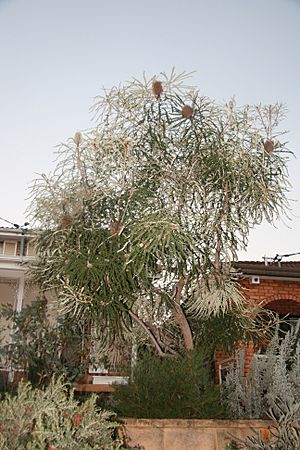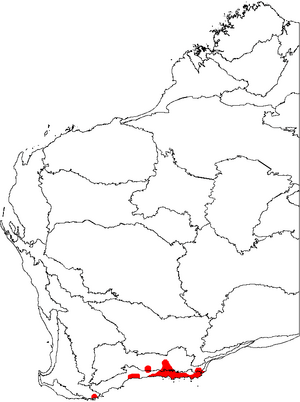Showy banksia facts for kids
Quick facts for kids Showy banksia |
|
|---|---|
 |
|
| Banksia speciosa inflorescence | |
| Scientific classification | |
| Kingdom: | |
| (unranked): | |
| (unranked): | |
| Order: | |
| Family: | |
| Genus: | |
| Subgenus: | |
| Section: | |
| Series: | |
| Species: |
B. speciosa
|
| Binomial name | |
| Banksia speciosa |
|
| Synonyms | |
|
Sirmuellera speciosa (R.Br.) Kuntze |
|
The Banksia speciosa, often called the showy banksia, is a type of large bush or small tree. It belongs to the Proteaceae plant family. You can find it along the south coast of Western Australia. It grows in sandy areas between Hopetoun and the Great Australian Bight.
This plant can grow up to 8 meters (26 feet) tall. It has a single stem and long, thin leaves. These leaves have unique triangular "teeth" along their edges. The leaves are usually 20 to 45 centimeters (8 to 18 inches) long. Bright cream-yellow flower spikes, called inflorescences, appear all year round. As these flowers get older, they form up to 20 seed pods, called follicles. These pods keep the seeds safe until a bushfire opens them. Even though it grows in many places, the showy banksia is very sensitive to a plant disease called dieback. Many groups of these plants have died because of this disease.
Robert Brown first collected and described this plant in the early 1800s. The showy banksia is part of the Banksia plant group. Its closest relative is B. baxteri. Showy banksia plants are killed by bushfires. However, new plants grow from the seeds released after a fire. The flowers attract birds that eat nectar and insects, especially honeyeaters. They also attract many different insects. When grown by people, the showy banksia grows well in sunny spots with good drainage. It needs areas with dry summers. It does not grow well in places with humid summers. However, it can be grafted onto other banksia types to help it grow in those areas.
Contents
What the Showy Banksia Looks Like

The showy banksia, or B. speciosa, can grow as a bush or a small tree. It reaches heights from 1 to 6 meters (3 to 20 feet), and sometimes even 8 meters (26 feet). It has many branches and a single main stem. The bark is smooth and grey. Unlike some other banksias, it does not have a special woody base called a lignotuber. New parts of the plant grow in summer and are covered in a rusty-colored fuzz.
Its leaves are long and thin, like lines. They are 20 to 45 centimeters (8 to 18 inches) long and 2 to 4 centimeters (0.8 to 1.6 inches) wide. The edges of the leaves have 20 to 42 noticeable triangular points. These points create a zigzag pattern. The spaces between these points are deep, almost reaching the middle vein of the leaf. The edges of the leaves curve slightly backward.
Flowers and Seed Pods
The cream to yellow flower spikes can appear at any time of the year. They grow at the ends of stems that are one or two years old. These spikes are shaped like cylinders with a rounded top. They are about 4 to 12 centimeters (1.6 to 4.7 inches) tall and 9 to 10 centimeters (3.5 to 3.9 inches) wide. Each spike is made up of many small flowers. One study found about 1369 flowers on each spike. The flowers are grey-cream when they are buds. They turn more yellow or cream as they open.
As the flower spikes get older, they turn grey. The old flowers stay on them. Then, up to 20 large, red seed pods, called follicles, grow on each spike. These pods are roughly oval and stick out from the spike. Each pod is about 3.5 to 5 centimeters (1.4 to 2 inches) long. They are covered in thick fur, which is red-brown at first and then turns grey. These pods stay closed until a bushfire opens them. Each pod holds one or two good seeds.
Seeds and Seedlings
The seeds are 3.7 to 4.5 centimeters (1.5 to 1.8 inches) long and quite flat. They have a main body and a papery wing. One side of the seed is grey, and the other is dark brown. The dark brown side has tiny hairs. The seeds are separated by a dark brown piece that is shaped like the seeds.
When a showy banksia seed sprouts, its first leaves, called cotyledons, are dull green. They are wider than they are long. The stem of the seedling is smooth and red. The next leaves that grow are arranged opposite each other. They have deep cuts with three triangular points on each side. The stem of the seedling is covered in white hair.
There is a slightly different type of showy banksia found near Gibson. It has an upright shape and leaves. Other than that, the showy banksia looks very similar across its whole area.
The Banksia baxteri looks similar to B. speciosa. Both grow in the western part of the showy banksia's range. However, B. baxteri has shorter, wider leaves with bigger points. Its flower spikes are also shorter, and it is a smaller, more open bush.
How Showy Banksia Was Named and Classified

The first person to collect this plant might have been Claude Riche. He was a naturalist on an expedition in 1791. He explored an area near Esperance Bay where B. speciosa is very common. However, he got lost and had to leave his plant collections behind.
The species was officially collected by Robert Brown in 1802. He then published its description in 1810. One of the early common names for it was "handsome banksia." Today, it is known as showy banksia or ricrac banksia. The name "ricrac" comes from the zigzag shape of its long, thin leaves.
Scientists classify plants into groups to understand them better. B. speciosa is part of the large Banksia genus. It is closely related to Banksia baxteri. Over the years, different scientists have studied and grouped banksias in various ways. Today, it is still placed within the main Banksia group.
Where Showy Banksia Lives
The showy banksia grows on sand dunes and sandy plains along the coast of Western Australia. You can find it in the Esperance Plains and Mallee regions. Its range stretches from East Mount Barren near Fitzgerald River National Park to Israelite Bay. It usually grows within 50 kilometers (31 miles) of the coast. It can also be found further inland near Mount Ragged. There is also a group of plants far to the east at Point Culver.
B. speciosa grows on flat or gently sloped ground with deep white or grey sand. It is often the main bush in these areas. It commonly grows with other plants like Lambertia inermis and other banksia species.
Life Cycle and How it Survives
The bright flower spikes of the showy banksia attract many birds and insects. Honeyeater birds are frequent visitors. These include the New Holland honeyeater and the western wattlebird. Other birds like the grey butcherbird also look for food here. Many insects, such as ants, bees, wasps, butterflies, moths, and beetles, also visit the flowers. The short-billed black cockatoo breaks off old flower spikes to eat the seeds.
The showy banksia is a serotinous plant. This means it stores its seeds in its canopy (the top part of the plant). The seeds are kept safe inside the pods on the old flower spikes. When a bushfire happens, the heat opens these pods. This releases many seeds. The seeds then sprout and grow after it rains. Seeds can stay good for many years. Old spikes, even 11 or 12 years old, can still have good seeds.
Young plants start to flower three years after a bushfire. They store more and more old flowerheads (and seeds) as they get older. Plants can live for at least 40 years. Even though many seeds are released, not all of them grow into new plants. However, the seedlings that do grow can get water more easily than other banksia species.
Threats to Showy Banksia
The showy banksia is very sensitive to a disease called dieback. This disease is caused by a fungus-like organism called Phytophthora cinnamomi. Many showy banksia plants in Cape Le Grand National Park and Cape Arid National Park have died from this disease. If you see showy banksia plants dying, it can be a sign that this disease is present.
Growing Showy Banksia
The showy banksia is a fast-growing and attractive plant. It grows easily in sunny places with dry weather and soil that drains well. However, it does not grow well in places with humid summers, like Australia's east coast. To help it grow in these areas, it can be grafted onto other banksia species.
The seeds do not need any special treatment to grow. They usually sprout in 27 to 41 days. The showy banksia is also grown to be used as a cut flower. It was even considered for growing on farms in Tenerife. Studies there showed that young plants could handle some salt in the soil.
Images for kids
-
Showy banksia in flower at Cape Le Grand National Park
See also
 In Spanish: Banksia vistosa para niños
In Spanish: Banksia vistosa para niños




